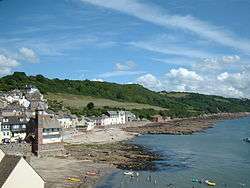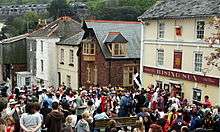Kingsand
Kingsand (Cornish: Porthruw) and Cawsand are twin villages in southeast Cornwall, United Kingdom.[1] The villages are situated on the Rame Peninsula and are in the parish of Maker-with-Rame.

Until boundary changes in 1844, Kingsand was in Devon; however, Cawsand has always been in Cornwall. On the old county boundary between the two villages, the house Devon Corn still displays the boundary marker.[2]
History
The villages are known for their smuggling and fishing past. Although the known smuggling tunnels have been sealed up, there are still old fish cellars and boat stores along the coast.
One notable former resident was John Pollard RN, a midshipman (later a Commander) who served in the Navy under Horatio Nelson. He is credited with being ‘Nelson's avenger’, since it was he who shot the French sailor who killed the Admiral.[3]
Another notable resident includes Tabitha Ransome (daughter of renowned writer Arthur Ransome)
Geography
Kingsand lies on the shores of Cawsand Bay, with the South West Coast Path running through the village.[1] The village coast, as well as the coast 1 km to the east, forms the Kingsand to Sandway Point SSSI (Site of Special Scientific Interest), which shows examples of extensive Early Permian volcanicity.[4]
Transport
Kingsand is connected via the Rame bus link to Plymouth. The Rame bus link runs between Cremyll and goes to Plymouth via Torpoint. During the summer, the Cawsand Ferry runs a passenger service between Cawsand Beach and the Mayflower Steps in Plymouth for visitors to the Barbican. Walkers can reach the village through Mount Edgcumbe Country Park.
Local landmarks
The Clock Tower and Institute

A key feature of the village is the clock tower along the seafront of Kingsand. It was erected to commemorate the coronation of King George V[5] and the building it is attached to, known as the Institute, is used as a community hall. The Institute also contains a large cross-stitch tapestry picture of the two villages, which was made by residents to commemorate the Golden Jubilee of Queen Elizabeth II.
Churches
Within the parish of Maker-with-Rame, there are three churches: the Church of St. Germanus, Rame which is near Rame Head; St. Andrew's Church in Cawsand; and the Church of St. Mary and St. Julian, Maker (which is located along the road towards Cremyll). Maker is the largest of the three and is highly visible from Torpoint and Plymouth. The former St Paul's Church was opened in 1882 as a chapel of ease to the Church of St Mary and St Julian. It is now the Maker with Rame Community Hall.
Beaches
There are three main beaches in the villages, which are separated by patches of rocks which have rock pools. Kingsand Beach is a mixture of sand and shingle, which is located along The Cleave. Girt Beach is mainly shingle, but with some sand and can be found along Market Street. Cawsand Beach is mainly sand and is found along The Bound. A swimming beach known as Sandways lies a short walk out of the village, across the rocks towards Fort Picklecombe.
The water quality has improved over recent years thanks to extensive sewerage works, and so all beaches are safe for swimming.[6]
Culture and community

The Black Prince Procession is a Mayday custom in the villages of Kingsand, Cawsand and Millbrook. The procession, where a flower-adorned boat is carried on the shoulders, begins in Millbrook and carries on through Kingsand and Cawsand to banish the harsh conditions of winter and welcome warmer summer weather and a fruitful land and sea harvest. Additional activities include the decoration of buildings, Morris dance and maypole dance, a fete and a town crier competition.[7] Black Prince refers to Edward the Black Prince (1330-1376), the first Duke of Cornwall.
In popular culture
Parts of the film Mr Turner were filmed in Kingsand, portraying Margate[8].
References
- Ordnance Survey: Landranger map sheet 201 Plymouth & Launceston ISBN 978-0-319-23146-3
- "Cawsand and Kingsand: Online guide to Cawsand and Kingsand - Rame Peninsula East Cornwall". Cornwall Online. Retrieved 3 March 2020.
- John Pollard, Nelson’s Avenger, ND 8 (2005): 615-620
- "Kingsand to Sandway Point" (PDF). Natural England. 1994. Archived from the original (PDF) on 24 October 2012. Retrieved 2 November 2011.
- Exploring South East Cornwall,Lightfoot. P, 2012, page 24
- Cawsand, Cornwall, Marine Conservation Society
- Hamill557. "May Day Black Prince Flower Boat Festival". Visit Rame. Retrieved 3 March 2020.
- "Mr Turner: Filming and Production". IMDb. Retrieved 3 March 2020.
